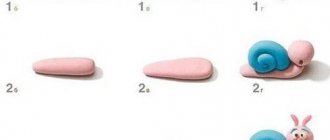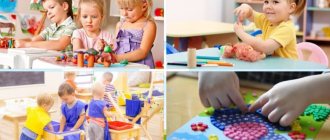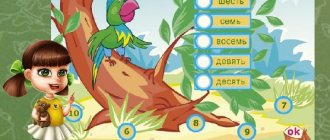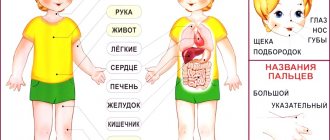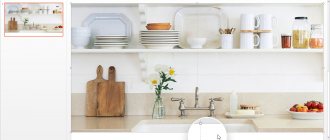Didactic games for visual arts in the senior group
Exercise:
The teacher shows the children a picture and says that a gnome came to visit the children; he brought gifts, but what the children must guess and draw.
D/I “Wonderful Forest”
Purpose:
To teach children to create situations in their imagination based on their schematic representation.
Material:
Sheets of paper on which several trees are drawn and unfinished, unformed images are located in different places.
Colour pencils.
Exercise:
The teacher hands out sheets of paper to the children and asks them to draw a forest.
full of miracles, and then come up with and tell a story about it.
D/I “Shifters”
Purpose:
To teach children to create in their imagination images of objects based on the perception of schematic images of individual parts of these objects.
Material:
Pencils. Sheets of paper with the image of half of an object.
Exercise:
The teacher invites the children to draw whatever they want to the figure, but so that it turns out to be a picture. Then you need to take another card with the same figure, put it upside down or sideways and turn the figure into another picture. When the children complete the task, take cards with another figure.
D/I “Make a portrait”
Target:
To consolidate knowledge about the genre of portraiture.
Develop a sense of proportion. Material:
Various modifications of face parts. Paper. Colour pencils.
Exercise:
The teacher invites children to make a portrait from different parts of the face.
Determine the mood and draw a portrait.
D/I "Underwater World"
Purpose of the game:
Strengthen children's knowledge about the inhabitants of the underwater world. Teach children to carefully examine the shape, color, and structural features of underwater inhabitants. Learn to create a multifaceted composition using underpainting. Develop fine motor skills. Activate children's vocabulary.
Material:
Illustrations depicting the inhabitants of the underwater world. Paper. Watercolor.
Exercise:
Together with the teacher, children remember who lives in the seas and oceans, clarify their body structure and coloring. Then, in the underpaintings, children create a picture of the underwater world, arranging objects in a multifaceted manner. The chip goes to the child who created a more interesting picture, the one who used a lot of details to create a picture of the underwater world.
D/I “Draw a warm picture”
Target:
Clarify with children the concepts of “warm and cool colors”;
continue to learn how to compose a picture from memory, using warm colors when coloring. Materials:
4 pictures depicting simple plots, geometric shapes found in these pictures, colored pencils, felt-tip pens, sheets of white paper.
Exercise:
Having carefully examined the uncolored sample picture, at the teacher’s signal, turn it over, depict the scene you saw on your sheet of paper, and color it, adhering to a warm palette.
Lesson notes on fine arts for preschoolers
Summary of GCD for children 6-7 years old on the topic “What color is the rainbow”
Author. Sokolova Svetlana Sergeevna, teacher of additional education, MBOU DOD Center for Children's Creativity, Syava village. Description of the material: I offer you a summary of direct educational activities for children 6-7 years old, 1 year of study in the additional educational program of the Art Studio club.
On the topic “What color is the rainbow.” This lesson summary will be useful for kindergarten teachers and 1st grade teachers in secondary schools. This summary of an educational lesson is an introductory one to the additional educational program of the Art Studio club. The teacher can select images for computer-based accompaniment of the lesson at his own discretion. The topic of the lesson is “What color is the rainbow”
Purpose : To familiarize children with the content of fine arts classes in the “Art Studio” circle. Identification of the level of knowledge, skills and abilities of children in the field of fine arts. Objectives: EDUCATIONAL: • To introduce the rules of work in the classroom and materials for fine arts classes. • Develop workplace organization skills and brush and paint skills. • Learn to depict a natural phenomenon without a preliminary drawing. DEVELOPMENTAL: • Develop the ability to accurately paint with watercolors. • Develop aesthetic responsiveness to the beauty of the surrounding world. • Develop visual memory in children and the ability to depict from memory and impression. EDUCATIONAL: • Cultivate interest in visual arts. • Cultivate a love for native nature and a caring attitude towards it. • Cultivate friendly relations in the team, the desire to help each other. Type of lesson: Learning new material. Type of lesson: Practical lesson with elements of conversation. Methods: Explanatory and illustrative, partly exploratory using the practical method. First year of study. Introduction to the additional educational program. Children's age. 6-7 years. Class time. 35 minutes. Equipment: For the teacher: - lesson presentation, - exhibition of children's drawings made in different techniques, - tape recorder, cassettes with melodies, - gouache. — For children: — album, — watercolor paints, — brush, — jar of water. Lesson plan. Organizational stage. 1 minute / greeting / • Preparatory stage. 8 minutes / message of the topic, goals and objectives / • Main stage. 20 minutes a/ theoretical. b/ practical. • Final stage. 5 minutes / summing up the lesson / • Reflective stage. 1 minute / self-assessment of the lesson / Progress of the lesson 1. Organizational stage. Goal: Organization of the workplace, psychological attitude towards the upcoming work. Greetings, checking the group for class. 2.Preparatory stage. Goal: Preparing children to perceive new lesson material. Teacher: - Let's get acquainted. My name is Svetlana Sergeevna, I am a fine arts teacher. - Now introduce yourself. (children say their names)
I really like to draw Trees, birds, and animals. I like to think and dream about the future life of the children. Smile, sunshine, for us more often. Smile, sunshine, for our happiness. (Slide 2: children’s drawings)
Teacher: - Look how many children's drawings are in our exhibition. Do you think the children who drew them like to draw? (exhibition of drawings, children's crafts), (children's answers)
Teacher: - Guys, do you like to draw?
(children's answers)
Teacher: - In fine arts classes, you and I will draw, sculpt, make various crafts, learn to depict all the amazing things that we can see around, invent, fantasize.
Teacher: Purpose of the lesson: Today we will draw a beautiful natural phenomenon - a rainbow. Let's learn the first techniques of working with paints and a brush. We will develop imagination, creative thinking, and the ability to work in pairs and independently. Teacher: - Guys, “The Cheerful Pencil” came to visit us and now he will play an interesting game “Artist’s Briefcase”, you need to guess the accessories necessary for drawing lessons. Guys, whoever knows the correct answer, raise up the signal - a colored pencil. (The game “Artist’s Briefcase” is played. The teacher asks riddles)
- In the morning I go to school and take the supplies.
I carry my house on my shoulders, and in it for drawing.... (Album) (slide 3: after the children’s answers, pictures of riddles appear on the screen)
- Who will color our album?
Well, of course... (Pencil) - Without fear, She dips her pigtail in paint, Then drags the colored braid across the page in the album. (Brush) - If you give her a job - The pencil worked in vain. (Eraser) - Multi-colored sisters Are bored without water Uncle is long and thin Carrying water with his beard. And the sisters together with him will draw a house and smoke. (Paints, brush) Teacher: - Well done, guys, you guessed the riddles correctly, and now let’s together correctly arrange our supplies on the desktop. 1. All accessories should be placed on the desktop so that they do not interfere with your work. 2.The drawing paper lies exactly in front of your eyes and is not blocked by anything. 3. Water and a box of paints are placed above the album. 4.On the right side (for left-handed people - on the left)
there is a pencil and a brush eraser.
Teacher: - Check whether you have correctly positioned the tools and materials for drawing (self-test by children using a reference signal) (slide 4)
Teacher: - Guys, what are the names of the paints that artists use?
Children: Watercolor, gouache, oil, stained glass paints. - Now we will play an interesting game “Colorful Paints”. There are jars of gouache on your tables. Name the colors of paints and say what you would paint with this color. On the children's tables there is a jar of paint (everyone has a different color). Work in pairs. (slide 5: paints are depicted on the screen. After the children answer, drawings of the sun, clouds, grass, etc. appear.)
3. Main stage.
a/ theoretical. Goal: To introduce children to the natural phenomenon of the rainbow and its characteristic features. Someone built multi-colored gates in the meadow. But it is not easy to pass through them, Those gates are high. The master tried, he took paints for the gates. Not one, not two, not three, look at seven. What is this gate called? Can you draw them? (rainbow) (slide 6: image of a rainbow)
Teacher: - An amazing phenomenon - a rainbow.
How does she appear in the sky? (children's answers, teacher's addition)
On a summer day, when there is warm rain, the sun's rays are refracted in water droplets.
- What is another name for this kind of rain? - Mushroom. - The rainbow has many names - rocker, ring, bridge. Teacher: - Guys, look at the image of the rainbow and name all its colors (children's answers) Teacher: - The colors of the rainbow are always arranged in a certain order. In order to remember this order, listen to the little rhyme: Every Hunter Wants to Know Where the Pheasant Sits. Teacher: - Using the initial letters of each word of this phrase, it is easy to remember the order of the colors located in the rainbow. Name them. Children: red, orange, yellow, green, blue, blue, purple. - Guys, now listen to what good advice for young artists “The Cheerful Pencil” will give you. — Gently wet the brush in water, wipe off any excess on the edge of the jar, or use a cloth to blot the brushes. — You can’t rub the brush on the paper and spoil its “hairstyle,” or keep it dipped in water. (hair becomes distorted)
- Rinse the brush every time so as not to stain the paint. - After work, the gouache must be tightly closed so that it.
not dry, and the watercolor, on the contrary, do not cover it, let the paint dry. — While painting, you need to sit straight so that the sharp tip of the brush does not get into your eye. Teacher: - Our friend “Cheerful Pencil” has prepared an interesting riddle for you - exercises. Physical education minute. I run on paper, I can do everything, I can do everything: (running in place)
If you want, I’ll draw a house,
(stand on your toes, arms up, depicting a roof)
If you want, a Christmas tree in the snow,
(squats)
If you want, an uncle, if you want, a garden.
(turns to the sides, hands on the belt)
Any child is happy to see me!
(jumping in place)
b/ practical Goal: Formation of practical skills of children in depicting a natural phenomenon - a rainbow.
Teacher: - Now let's all draw a rainbow together: - place the sheet horizontally; - take paints that need to be moistened with water in advance; -draw the first arc-shaped line in red, pressing the entire bristle of the brush to the paper; — place all the stripes of the rainbow close to each other. / independent practical work of children, accompanied by musical accompaniment / (slide 7)
4. Final stage.
Purpose: Summarizing the work done in the lesson. • Game “Colors of the Rainbow” Teacher: Guys, the colors of the rainbow are mixed. Help place them in the correct order (children place colored pencils at the board in accordance with the spectrum of the rainbow) (slide
• Summarizing the material learned in class. — What will we do in fine arts classes? — What laws of young artists do you remember? — So that you would like to tell your friends and parents about our lesson? • Exhibition of children's works and their discussion. Teacher: - Guys, you made a wonderful rainbow. What helped you portray her? Children: - Multi-colored paints. 5. Reflective stage. Goal: Self-assessment of the emotional state of children in class. Teacher: - Guys, on your table there are pictures of the sun and drops of water, if you liked the lesson and you are in a good mood, raise the sun, and if you are in a bad mood, then show a drop of water.
We recommend watching:
Tournament "Funny Colors" for children in grades 5-7. Scenario
Summary of an integrated lesson in fine arts and music for students in grades 5-6
Drawing lesson for primary schoolchildren on the topic: Winter in the forest
Scenario of extracurricular activities on MHC in 5th grade
Similar articles:
Lesson notes on fine arts, 8th grade. Design and architecture in human life
Lesson summary on fine arts in grades 5 - 6
Development of an integrated lesson on fine arts and artistic work
Japanese painting technique sumi-yo
Club lesson summary. Wood painting
